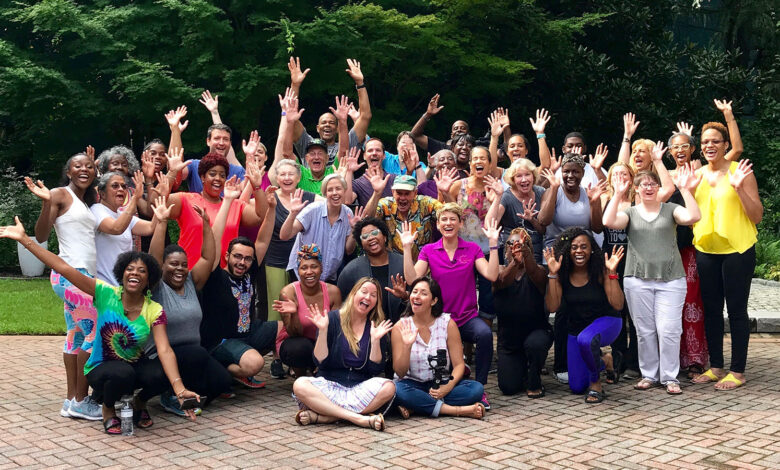
(RNS) — Wearing a bright pink tank top, Celeste Greene enthusiastically pops off the Zoom screen, clapping as she chants: “HO HO. HA HA HA. HO HO. HA HA HA. YAY,” each smack of her forceful hands punctuating her laugh. On the final yay, Greene lifts her arms to the sky and belly laughs.
A Santa Claus training for Macy’s? A kindergarten music class?
Greene is a certified laughter yoga teacher in Atlanta, and her online and in-person classes offer the benefits of chuckling, guffawing and belly laughing, which, whether deliberate or spontaneous, science says, can reduce stress and increase the flow of oxygen to the brain.
“You can just go through the motions of laughter and get the health benefits similar to an aerobic workout,” Greene said in a recent interview. “You don’t need to be in a good mood or genuinely laugh to receive the benefits. It takes the pressure off.”
Greene, 42, became a certified laughter yoga leader in 2010 after she was laid off from her marketing job and fell into a bout of depression. Looking for ways to find joy again, she came across a laughter yoga leader training in Florida. “I had a severance check, so I thought I’d go laugh with people in Florida,” she said.
Since then, Greene has used her marketing skills and the power of a good laugh to grow her business, which now includes private workshops, leader trainings and three “laughter clubs” — free laughter yoga meetups, in-person and on Zoom, led by laughter yoga leaders. Her YouTube channel has nearly 9,000 subscribers.

Madan Kataria, center, leads a laughter yoga training program in Finland in 2009. (Photo by Nauravainenanu/Wikimedia/Creative Commons)
Laughter yoga combines yoga’s breath work and gentle movement with laughter therapy, the ancient practice of effectively using laughter to minimize stresses. Laughter yoga began in Mumbai, India, in 1995 when a doctor named Madan Kataria developed the practice to reduce the stress of running his medical practice, based on research studies touting the benefits of laughter. One that stood out said your brain can’t tell the difference between real or fake laughter.
“Laughter yoga is not a comedy,” Kataria said in an interview from Jaipur, where he’s helping a school introduce laughter yoga into its curriculum. “It’s an exercise program based on breathing. Your brain and body cannot distinguish difference between acting and real laughing. They create the same happy chemicals.”
Today, the movement, Laughter Yoga International, involves 25,000 leaders in 130 countries, including a chapter in the United States that was established in 2016. There are 396 laughter yoga leaders and 74 laughter yoga teachers (able to teach others) in America.
Alexa Fong Drubay, director of Laughter Yoga USA and one of only four laughter yoga master trainers in America, said those who do the leader training are expected to start a laughing club as a free offering to their communities. An online database allows anyone to find either virtual or physical laughter clubs.
Anyone can become a laughter yoga leader and teacher, and you don’t need to be a yoga teacher to do the training. Drubay trains social workers, therapists, counselors, nurses, doctors, health coaches, hospice workers and pastors. Those interested in leading laughter yoga first become a certified laughter yoga leader through two days of training and from there can become a certified laughter yoga teacher through five days of training with a master trainer and then a certified master trainer, the highest level of training with Kataria himself.
“Regardless of our faith, political backgrounds or socio-economic backgrounds, we come together and laugh to feel good and celebrate the moment,” said Drubay. “Connecting heart to heart through laughter and learning how to laugh through challenges really is the best medicine of all.”
According to Laughing in Salem, a laughing club led by three laughter yoga leaders in Oregon, a typical class begins with clapping and warm-up laughter exercises like clapping and chanting “ho ho ha ha ha” in a 1-2, 1-2-3 rhythm. The laughing exercises are freeform, and a typical session will have around 30 exercises, each interspersed with deep breathing and childlike playfulness. The leader may use cheers like “very good” (clap), “very good” (clap) “yay,” (swing arms in a “Y” shape over the head). One exercise is finding a partner and speaking gibberish with them as if you are having a serious conversation. Another is to pretend you are on a phone call and the person tells you something funny. Finally, a meditation is offered to close the session and bring the energy back down and create a sense of calm.
Donna Patterson, a retired United Methodist clergywoman living in Greensboro, North Carolina, found the practice in Nashville, Tennessee, in 2019 and used it for her Doctor of Ministry coursework. She introduced laughter yoga to clergy who found themselves stretched thin during natural disasters. “I’ve found it to be beneficial to everyone,” said Patterson. “Even those who just watch … have a smile on their face and have gained something by watching others.”
Josie Flores, a professional relations liaison at Empath Health, is one of several employees at Empath who leads laughter yoga at senior centers in Florida. One of her teammates introduced the practice to employees. At first, “I wasn’t sure about it,” she said. “It was a good challenge for me. How many times in our daily life do we get to be silly?”
Flores chooses to play music in her classes, which isn’t typical in laughter yoga, and takes the older residents on “trips,” whether it’s to England with the Beatles or to Hawaii with the Beach Boys. Flores said that laughter yoga helps bring “delight and light” to patients and grieving families.

Josie Flores, standing top center, leads a laughter wellness session at an Empath Health senior center in Florida. (Image courtesy of Empath Health)
Kataria, Greene and other laughter yoga leaders said they make a point to laugh for 10 to 15 minutes every day, whether it’s while they are getting ready, doing household chores or sitting in traffic. Greene joked that there is “ample opportunity to practice in Atlanta.”
For people wanting to try laughter yoga, leaders suggest using the laughing club finder or trying a YouTube video like Greene’s offerings, but they emphasized eventually doing it in person, as you get the most benefits from making eye contact with others and being in community while laughing.
While it can be intimidating to forcefully laugh in public with strangers, Tabatha Mann said attending a class was nothing but a positive experience. The North Carolina group fitness director told RNS, “When getting together with a group of people, moving and laughing, there can only be positive outcomes!”
Kataria emphasized that every human is hard-wired to laugh, and it’s our universal language. He said that laughter yoga changes the way one looks at the world. “When you laugh, you change. You become generous, forgiving and grateful,” he said. “And when you change, the world changes.”
Source link




